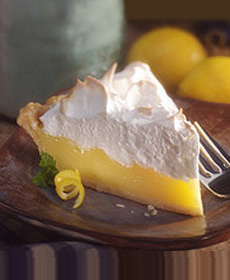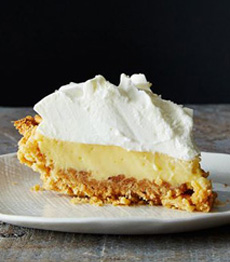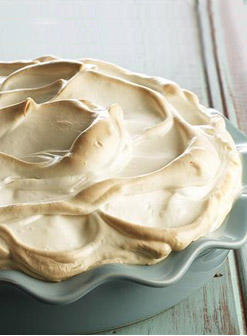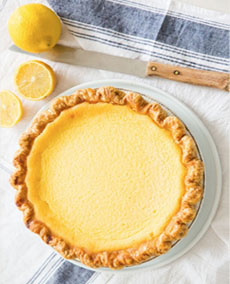RECIPE: Atlantic Beach Pie, A Spin On Lemon Meringue Pie

|
August 15th is National Lemon Meringue Pie Day, celebrating one of America’s favorite pies. THE HISTORY OF LEMON MERINGUE PIE Lemon-flavored custards, puddings and pies date to the Middle Ages, which concluded in the 15th century. Meringue was perfected in the 17th century. The modern lemon meringue pie is a 19th-century recipe, attributed to Alexander Frehse, a baker in the Swiss canton of Romandie. By the late 19th century, the dish had reached the U.S. and achieved popularity. It combines a lemon custard single crust pie with meringue, the fluffy topping made from egg whites and sugar, baked on top. Here’s the classic lemon meringue pie recipe. Fast-forward a century to Atlantic Beach Lemon Pie, a Southern specialty from the beaches of North Carolina. It’s a lemon meringue pie with a twist: It has a crunchy, salty crust made from crushed saltine or Ritz cracker crumbs. It fell out of fashion for decades, until it was rescued from obscurity by Chef Bill Smith of Crook’s Corner in Chapel Hill, North Carolina. Chef Bill added his own touch, substituting whipped cream for the meringue topping. Chef Bill has been generous with his recipe. We encountered this recipe in OurState, magazine in Greensboro, North Carolina, whose editor asked him to write about it. Here’s the original article. RECIPE: ATLANTIC BEACH PIE Ingredients For The Crust 1. PREHEAT the oven to 350°F. Place the crackers in a plastic bag, seal and crush crush with a rolling pin into tiny, flaky pieces. You will have about 2½ to 3 cups of cracker crumbs. Do not use a food processor or you will end up with cracker dust that doesn’t work. 2. ADD the sugar, then knead in the butter until the crumbs hold together like dough. Press into an 8-inch pie pan. Chill for 15 minutes, then bake for 18 minutes or until the crust colors a little. While the crust is cooling… 3. BEAT the egg yolks into the milk, then beat in the citrus juice. It is important to completely combine these ingredients. 5. POUR into the shell and bake for 16 minutes until the filling has set. The pie needs to be completely cold to be sliced. Serve with fresh whipped cream and a sprinkling of sea salt. Check out the different types of pie in our yummy Pie Glossary. The ancient Egyptians, who were great bread bakers, worked out the details of early pastry. Theirs was a savory pastry: a dough of flour and water paste to wrap around meat and soak up the juices as it cooked. |
|
|
Before the creation of baking pans in the 19th century, the coffin, as it was called (the word for a basket or box), was used to bake all food. Pastry was further developed in the Middle East and brought to Mediterranean Europe by the Muslims in the 7th century. Another leap occurred in the 11th Century, when Crusaders brought phyllo dough back to Northern Europe (the First Crusade was 1096 to 1099). Greek and Roman pastry did not progress as far as it could have because both cultures used oil, which can’t create a stiff pastry. In medieval Northern Europe, the traditional use of lard and butter instead of oil for cooking hastened the development of other pastry types. Pies developed, and the stiff pie pastry was used to provide a casing for the various fillings. By the 17th century, flaky and puff pastries were in use, developed by French and Italian Renaissance chefs. These pastry chefs began to make highly decorated pastry, working intricate patterns on the crusts. |
||


